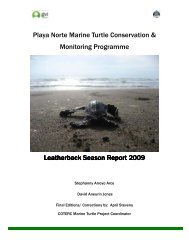Mariposa azul (Spanish) Morpho paleides Class: Insecta Order ...
Mariposa azul (Spanish) Morpho paleides Class: Insecta Order ...
Mariposa azul (Spanish) Morpho paleides Class: Insecta Order ...
Create successful ePaper yourself
Turn your PDF publications into a flip-book with our unique Google optimized e-Paper software.
<strong>Mariposa</strong> <strong>azul</strong> (<strong>Spanish</strong>)<br />
<strong>Morpho</strong> <strong>paleides</strong><br />
<strong>Class</strong>: <strong>Insecta</strong><br />
<strong>Order</strong>: Lepidoptera<br />
Family: Nymphalidae<br />
Genus: <strong>Morpho</strong><br />
Distribution<br />
Central and South America,<br />
and parts of Mexico<br />
Habitat<br />
Tropical rainforests<br />
Food<br />
As a caterpillar it chews on<br />
a variety of leaves. As an<br />
adult it feeds primarily on<br />
rotting fruit and sap.<br />
Reproduction<br />
Male butterflies release<br />
pheromones to attract<br />
females. She lays her<br />
fertilized eggs and flies off.<br />
Eggs hatch after nine days<br />
into caterpillars.<br />
Development<br />
The entire life cycle is 115<br />
days, most of which is<br />
spent as caterpillars. They<br />
live to reproduce.<br />
In this genus there are approximately 80 species, many of which<br />
are partly or mostly blue in colour. <strong>Morpho</strong> <strong>paleides</strong> occurs in Latin<br />
America from Mexico to Columbia, Paraguay and Trinidad.<br />
Adults spend most of their time on the forest floor and in the<br />
lower shrubs and trees of the understory.<br />
Diet changes with each stage of the lifecycle. The caterpillars<br />
chew on many plants, showing a preference for those in the pea<br />
family. Like all butterflies adults drink their food. They have a<br />
mouthpart called a proboscis used as a drinking straw to sip on<br />
the juice of rotting fruit and sap. They taste food with sensors<br />
on their legs before drinking it.<br />
When looking for mates, blue morpho males fly through all<br />
layers of the forest, releasing pheromones from their wings as an<br />
attractant to as many females as possible. When ova positioning<br />
the females are selective in choosing plants, they appear to have<br />
preferences.<br />
Eggs hatch into larvae, or caterpillars. At this stage they are<br />
reddish-brown with bright patches of lime green. Caterpillars<br />
after a period of time wrap themselves into chrysalises, the<br />
pupae stage. When pupation ends they transform into mature<br />
butterflies. This process is known as metamorphosis, a truly<br />
spectacular transformation.
Characteristics<br />
There are over fifty species<br />
of Blue <strong>Morpho</strong>s. The only<br />
difference being wing size<br />
and colour. They appear an<br />
iridescent blue on the upper<br />
side with spotted<br />
underwings, in brown,<br />
bronze and white.<br />
Adaptations<br />
The iridescent lamellae are<br />
only present on the dorsal<br />
side of the wings, leaving<br />
the ventral side less<br />
colourful. Crypsis is put<br />
into effect when the wings<br />
are folded.<br />
They are solar powered,<br />
using the sun to warm<br />
themselves.<br />
Butterflies taste-smell the<br />
air with their antennae.<br />
Status/Threats<br />
In the wild they are<br />
threatened by deforestation<br />
of tropical forests and<br />
habitat fragmentation.<br />
Sightings at Caño Palma<br />
In and around the<br />
compound, and on the<br />
trails. Along the canal,<br />
usually in flight.<br />
<strong>Morpho</strong> <strong>paleides</strong> has a wingspan of around 13 to 20 cm. The<br />
scales on the wing tops are not pigmented blue. All butterflies<br />
have tiny overlapping scales covering the wings. On the morpho<br />
these scales have tiny ridges that reflect blue light, causing them<br />
to appear a brilliant iridescent blue. The ventral side though<br />
drabber is decorated with several ocelli or eyespots.<br />
The males’ wings are broader and appear brighter in colour.<br />
Blue morphos, like other butterflies, have two antennas, two<br />
fore wings and two hind wings.<br />
When these butterflies are in flight the contrasting colours of the<br />
wings flash from bright blue to brown making them look like<br />
they are appearing and disappearing. When at rest with their<br />
wings folded and the blue hidden they are well camouflaged,<br />
blending in with their surroundings. They remain hidden from<br />
enemies. If discovered the ocelli look like eyes, and help to scare<br />
off predators. Their own eyes are composed of thousands of<br />
tiny lenses that allow them to see in all directions. They see more<br />
colours than humans do. The eyes are thought to be highly<br />
sensitive to UV light making them able to see each other from<br />
great distances.<br />
As caterpillars they are very vulnerable. They have a variety of<br />
natural predators including birds and other large insects.<br />
Humans provide a direct threat by catching and killing them to<br />
provide collectors and admirers from around the world with<br />
display items. Nowadays there are large butterfly farms<br />
producing them for commercial distribution.<br />
Three species of blue morpho are seen around the station area<br />
and on the trails. They are often spotted in sunny clearings<br />
warming themselves. The main way they are seen is travelling<br />
through the forest or along the canal. Their characteristic flight<br />
makes them appear to be floating and easy to catch. This is very<br />
misleading as they can be quite evasive.<br />
References<br />
http;//www.rainforest-alliance.org/resources/forest-facts/species-profiles/morpho_butterfly<br />
http://ww.earthsbirthday.org/explore/kids/factsbluemorpho.htm<br />
http://www.broward.cc.fl.us/~ssimpson/Blue<strong>Morpho</strong>.htm<br />
http://www.amersol.edu.pe/ms/7th/7block/jungle_research/caeds/caed28.html<br />
Canadian Organization for Tropical Education and Rainforest Conservation<br />
www.coterc.org




